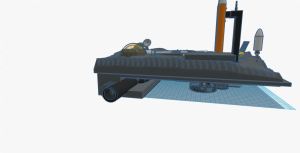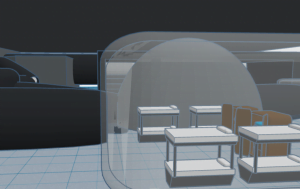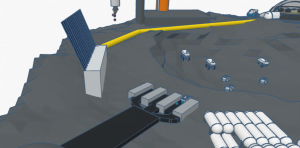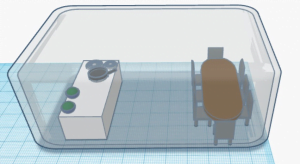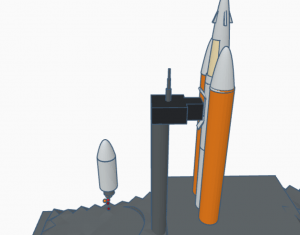Moon Camp Explorers Gallery 2020-2021
In Moon Camp Explorers each team’s mission is to 3D design a complete Moon Camp using Tinkercad. They also have to explain how they will use local resources, protect astronauts from the dangerous of space and describe the living and working facilities.
Team: The Isemo
International School of Toulouse Colomiers France 13, 12, 11
External link for 3d
|
Project description
The Isemo (International Science Exploration Moon Outpost) will be used as a scientific research centre. It will house eight people maximum and has one botany room and two dormitories – one for female and one for male, both fitted with bathrooms. The base also consists of a central base, a quiet library, a communications room, and a kitchen and eating area. We are aiming to create a fully functioning, self-sufficient base with ample production of water, oxygen, and food. We called the base Isemo because our main goal is scientific exploration. Our base will be mostly underground to protect against radiation and will be made of inflatable domes covered in lunar soil compacted together tightly. Every three months a space shuttle will arrive to the Isemo with four new scientists to limit the length of time any one person spends in space. These will include one biologist, one physician, one astronomer and one chemist. These people will contribute to the conduction of various experiments on the Moon. The shuttle will deliver equipment and some rations of space food every three months along with the four new astronauts. In our maiden voyage, we will have six robots sent up to build the base and report back living conditions. They will use the lunar soil and compact it and lay it down as a base for the main buildings which will be sent up later. The robots will also carve away a section underground for the rest of the base. |
|||
|
Where do you want to build your Moon Camp?
Close to the Lunar Poles Why did you choose this location?
Our base will be located on the south pole near the Calvus Crater. We have chosen this location because the crater is surrounded by flat land making it faster and more efficient to build on. There have also been reports from NASA’s Sophia that there is water on the Moon. While there may be low amounts of water (thus preventing us from using this as a reliable water source) this could be a reason to send scientists up there to look at the crater and work out the history of the lunar environment and whether more water or life may exist. How do you plan to build your Moon Camp? Which materials would you use?
We are planning to make the Isemo inflatable in order to reduce transportation cost and facilitate start up. We will start with the main area and botany room. Then every three months, with the astronauts, we will send up another inflatable section. The botany room, laboratory and main rooms are the most important to survive and thus will be our priority to start with. These rooms will be located on the surface of the Moon and covered with compressed lunar soil to protect the astronauts against radiation and meteorites. The rooms will have 4 windows on top of the dome. Explain how your Moon Camp will provide the astronauts with:
|
|||
|
Water
|
Food
|
Electricity
|
Air
|
|
We will transform the astronaut’s urine into sterile drinking water. We will use filtration to separate it from the manure and then distillate it again and again so that the urine is purified into clean drinking water. We will also have some water brought up from Earth to ensure that there is enough water on the Moon for health and hygienity. For experimental purposes, we will mine the water on the Calvus Crater using distillation and other filtration methods. |
To grow food, we will have an aerobic botany room that will produce various plants which contribute to a wholesome diet. These plants will be brought up from Earth in the form of seeds. We will also bring up worms and fresh soil at first in order to maximize the efficiency of plant growth and nutriment. We will use recycled manure to keep the soil healthy and the plants happy. We are planning to grow plants such as spinach, broccoli, potatoes, cucumber and carrots. For fruits we are planning to grow strawberries and blueberries. |
Power will consist of 200 space solar panels at a 75° angle and a nuclear reactor. These will both together will create 10 Megawatts every 12 hours. To make the nuclear reactor more efficient we will make use of aluminium and smelted iron. This power can provide us with the electricity we need to charge the base and the Rovers. We will use the sun’s power pre-cook the food throughout the day and the night to reduce power output and surges. We will use an electric solar-powered microwave to re-heat it. |
Breathable gasses will be stored in cryogenic tanks. These will undergo electrolysis, which separates hydrogen and oxygen. However, this cannot be done on the shuttle because hydrogen is flammable. Therefore, we will also make use of synthetic rock called zeolite. When cabin fans blow, water and oxygen stick to zeolite. The zeolite can be recharged by heating it up and exposing it to the vacuum of space. Zeolite filters nitrogen from the air, providing a high concentration of oxygen. A Sabatier reactor will be used to recycle hydrogen and carbon dioxide. The methane that is produced will be pumped overboard. |
|
Describe a day on the Moon for one of your Moon Camp astronauts
The day would start with the astronauts waking up at 7:30 and making their bed. All astronauts will take a shower which would be mandatory so that the base does not get infected and is kept clean. Between 8:30 and 9:00, the astronauts will have a meal consisting of any fruit and roasted potatoes from the botany room. The astronauts will do a base check between 9:00 and 10:30 and check that everything is in order and clean. Between 10:30 and 13:00, each astronaut will do an individual science session to progress in their specific field of science and remain up to date on the latest research. Then between 13:00 and 14:00, the astronauts will have free time where they read books in the library, chat to family and have a small snack. Then between 14:00 and 15:30 the astronauts will go back to the laboratory and work on data collection and exploratory analysis. Two astronauts will then go to the communication building to check for any meteors and report back to HQ. Another two astronauts will cook food for the following day. Two more astronauts will do some farming and the last two astronauts will repair any broken robots. If a rocket is landing, they will be the ones who welcome the new astronauts. This will normally be between 15:30 and 17:30. The astronauts will then have dinner and read a book between 17:30 and 19:00. Then they will have a shower and go to bed at 20:30. |
|||


